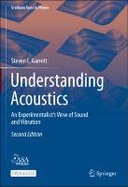Explore

This open access textbook, like Rayleigh’s classic Theory of Sound, focuses on experiments and on approximation techniques rather than mathematical rigor. The second edition has benefited from comments and corrections provided by many acousticians, in particular those who have used the first edition in undergraduate and graduate courses. For example, phasor notation has been added to clearly distinguish complex variables, and there is a new section on radiation from an unbaffled piston. Drawing on over 40 years of teaching experience at UCLA, the Naval Postgraduate School, and Penn State, the author presents a uniform methodology, based on hydrodynamic fundamentals for analysis of lumped-element systems and wave propagation that can accommodate dissipative mechanisms and geometrically-complex media. Five chapters on vibration and elastic waves highlight modern applications, including viscoelasticity and resonance techniques for measurement of elastic moduli, while introducing analytical techniques and approximation strategies that are revisited in nine subsequent chapters describing all aspects of generation, transmission, scattering, and reception of waves in fluids. Problems integrate multiple concepts, and several include experimental data to provide experience in choosing optimal strategies for extraction of experimental results and their uncertainties. Fundamental physical principles that do not ordinarily appear in other acoustics textbooks, like adiabatic invariance, similitude, the Kramers-Kronig relations, and the equipartition theorem, are shown to provide independent tests of results obtained from numerical solutions, commercial software, and simulations. Thanks to the Veneklasen Research Foundation, this popular textbook is now open access, making the e-book available for free download worldwide. Provides graduate-level treatment of acoustics and vibration suitable for use in courses, for self-study, and as a reference Highlights fundamental physical principles that can provide independent tests of the validity of numerical solutions, commercial software, and computer simulations Demonstrates approximation techniques that greatly simplify the mathematics without a substantial decrease in accuracy Incorporates a hydrodynamic approach to the acoustics of sound in fluids that provides a uniform methodology for analysis of lumped-element systems and wave propagation Emphasizes actual applications as examples of topics explained in the text Includes realistic end-of-chapter problems, some including experimental data, as well as a Solutions Manual for instructors. Features “Talk Like an Acoustician“ boxes to highlight key terms introduced in the text.
This book is included in DOAB.
Why read this book? Have your say.
You must be logged in to comment.
Rights Information
Are you the author or publisher of this work? If so, you can claim it as yours by registering as an Unglue.it rights holder.Downloads
This work has been downloaded 110 times via unglue.it ebook links.
- 110 - pdf (CC BY) at OAPEN Library.
Keywords
- Acoustic & sound engineering
- Acoustic levitation
- Acoustic radiation
- Acoustic wave propagation
- Acoustics
- Acoustics textbook
- Approximation techniques
- classical mechanics
- Elastic waves
- Electroacoustic transduction
- Engineering Acoustics
- Harmonic oscillators
- Mathematics & science
- Mechanical engineering
- Mechanical engineering & materials
- Modes of enclosures
- Nonlinear acoustics
- open access
- Other technologies & applied sciences
- Physical acoustics
- Physics
- Similitude in acoustics and vibration
- Technology, engineering, agriculture
- Textbook
- thema EDItEUR::P Mathematics and Science::PH Physics::PHD Classical mechanics::PHDS Wave mechanics (vibration and acoustics)
- Wave mechanics (vibration & acoustics)
- waveguides
- Waves in fluids
Links
DOI: 10.1007/978-3-030-44787-8Editions

